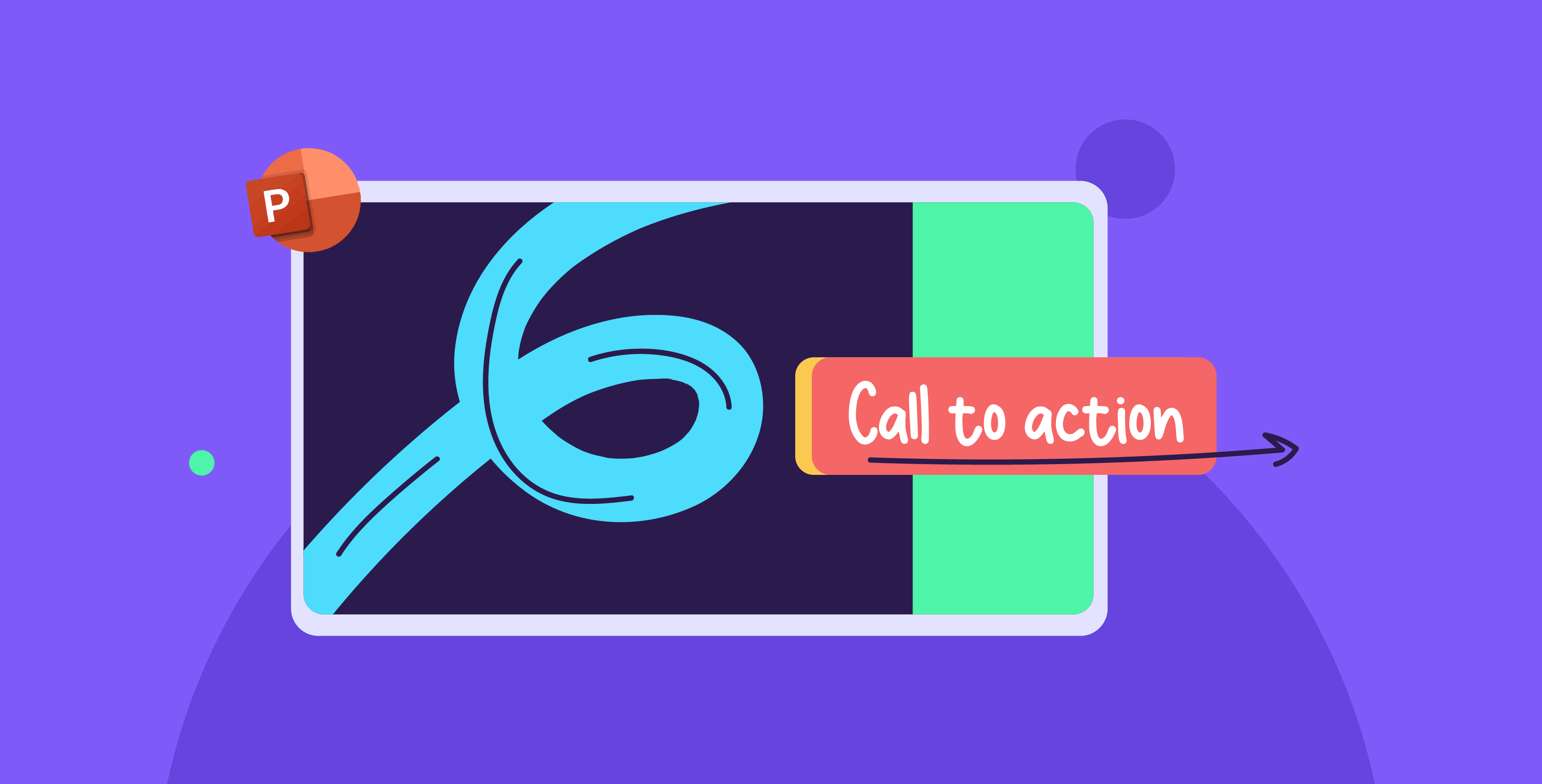09 May 2024
Presentations are powerful and essential tools, but without a clear call to action (CTA), they’re just fancy slideshows. While delivering data-driven insights is crucial, it is the final nudge that lets your presentation turn information into action. A well-crafted CTA is a bridge between powerful content and the desired action points and engagement.
This is the catalyst that drives the audience to create an impact with what they have learned. In this blog, we will discuss what makes a call to action so important and how to maximize their impact to turn listeners into active participants.
What is a CTA (call to action)?
A call to action (CTA) is a prompt encouraging a group to take a desired action. For presentations, CTAs play a super important role in driving audience engagement and guiding them toward specific outcomes. Whether using a service, approving a budget, or providing feedback, CTAs close the gap between delivering information and inspiring action.
CTAs should be strategically placed in slides to ensure that the presentation actually motivates the audience to take further steps. Effective CTAs can generate traffic and leads, move projects forward, and more, making them essential. However, just adding a CTA button or link without clarifying it to the audience renders it ineffective.
Here, we will explore the different strategies to successfully implement them to truly maximize their impact.
Why are CTAs crucial in consulting presentations?
A call to action is vital to presentations, particularly in consulting, since they aim to persuade stakeholders, influence decision-makers, and drive specific actions. They help achieve these outcomes by providing the audience with clear steps to follow.
First, they drive engagement. They make the slides more goal-oriented and even interactive. They trigger engagement and ensure that the audience is attentive and involved throughout, maintaining interest and focus.
They also guide the audience towards desired actions and clarify expectations and next steps. By structuring a talk around specific CTAs, a presenter can direct the audience through the data purposefully and lead them to the intended outcome.
Finally, CTAs can simplify complex information since they break it down into actionable steps. This helps the audience grasp key objectives more easily and keeps them focused on the main concepts. A call to action can ensure that a presentation remains concise by preventing information overload and enhancing overall comprehension.
Crafting effective CTAs
To create a call to action that is actually effective and drives meaningful action, it is necessary to consider certain techniques. These would make sure that the CTA is clear and, more importantly, impactful.
Make your CTA stand out
You can utilize design knowledge to make your CTAs stand out in your slides. Contrasting colors, bold fonts, and eye-catching icons are all ways to make it pop on the slide. The most effective CTAs attract attention with features such as size, positioning, and/or font choice. It is always helpful to test a CTA’s visual appeal and clarity by testing it out and seeking feedback to ensure it drives the desired response.
Use strategic placement
Positioning a CTA strategically is key to maximizing its effectiveness, whether it is on a website, a PowerPoint slide, or an email newsletter. It should be placed where it can easily be noticed and fits within the content’s natural flow. In a presentation, this is usually after a compelling argument is made or benefits are highlighted. By considering a user’s journey and the logical flow of information, a CTA will feel like the natural next step.
Highlight the benefits of following the CTA
When creating a call to action, it’s important to highlight the benefits of taking the desired action. You can highlight their value and importance by emphasizing their advantages and outcomes. When the benefits are relevant to your audience’s interests and needs, they will likely respond to the CTA much more if it is well-articulated.
Create a sense of urgency
Creating a sense of urgency would significantly boost engagement and prompt action, without compromising professionalism. Using phrases like “act now” or “don’t miss out” helps convey a sense of urgency. Plus, imposing a time limit on when the action needs to be taken pushes for a more efficient response. This technique can be especially useful when you want your audience to commit to a decision quickly but still want to be professional and respectful.
Integrating CTAs seamlessly into presentations
It is one thing to create an effective CTA, smoothly incorporating it into your presentation is a whole other thing. It’s very important to make the call to action seem natural and not be pushy about it. Here are some things to keep in mind as you merge them into your slides:
Placement of CTAs
Where you place a call to action helps guide your audience more directly to take action. They should be located in strategic areas where they can make an impact, for example, in a presentation that could be after a key section or after compelling data. It’s also important to balance the frequency of your CTAs to avoid overwhelming or putting off your audience. Instead of cluttering action buttons all over, focus on specific, well-placed ones that reinforce and align with your main points. This ensures that the CTAs fit in with the presentations’ flow without distracting from the core message.
The visual design of CTAs
One way of guiding an audience toward your CTA is through visual design. Using bold colors, distinctive shapes, and the aforementioned strategic placement, you can highlight the call to action and guarantee that it grabs the audience’s attention. However, make sure to maintain harmony; it should stand out without disrupting the overall aesthetic.
Supporting CTAs with data and insights
Supporting CTAs with data can significantly enhance their effectiveness. By backing them up with solid data, you provide a foundation for your audience to fall back on. Additionally, using features such as case studies or testimonials reinforces the CTA and adds credibility and context, making it more trustworthy. This makes the audience feel more confident in taking on the next step.
Call to action is the unsung heroes of presentations. They are the final piece of the puzzle that solidifies the influence of a slide deck. By understanding how a great CTA works and matching their placement and intent, you can elevate your slides to new levels. A strong CTA is about inspiring action and giving the audience true direction after you’re done, making the intent clear, compelling, and unforgettable.







